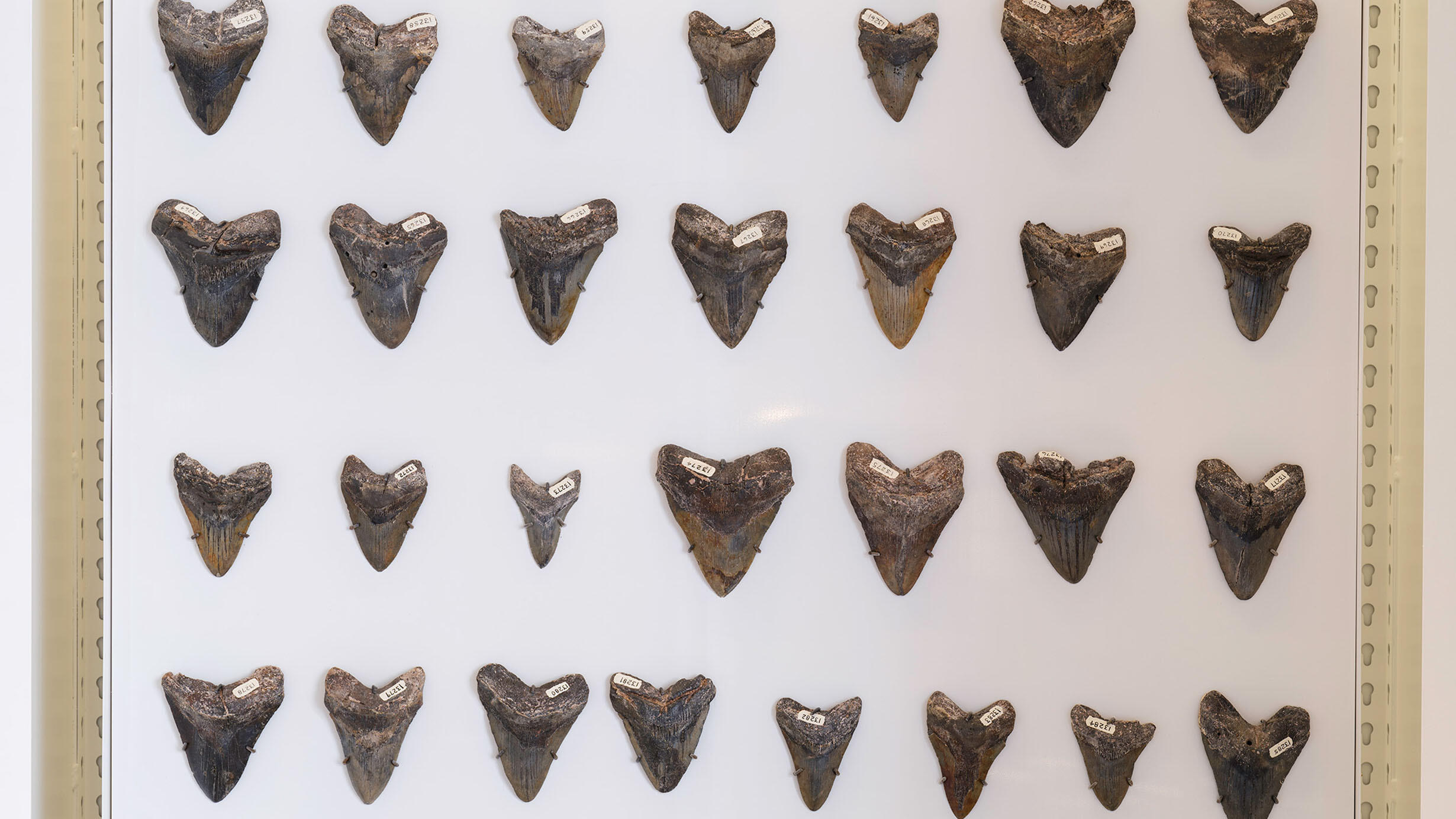 An array of fossilized Megalodon teeth on display in the Louis V. Gerstner, Jr. Collections Core, part of the Museum’s new Richard Gilder Center for Science, Education, and Innovation.
An array of fossilized Megalodon teeth on display in the Louis V. Gerstner, Jr. Collections Core, part of the Museum’s new Richard Gilder Center for Science, Education, and Innovation.Alvaro Keding/© AMNH
The prehistoric predator megalodon is often portrayed as a gigantic version of the great white shark. But a new study reveals that megalodon likely had less bulk than previously thought.
Earlier studies of megalodon (Otodus megalodon), which lived roughly 15-3.6 million years ago, estimate that the super-sized shark reached lengths of at least 50-65 feet (15-20 meters), based on models that compare the extinct species to the great white shark. This understanding of the megapredator is largely drawn from fossils of its teeth and vertebrae.
“Shark teeth are one of the most common vertebrate fossils that you can find, but their skeletons are exceptionally rare,” said John Maisey, an emeritus curator in the Museum’s Division of Paleontology and a co-author of the new study in the journal Palaeontologia Electronica. “Sharks and their relatives don’t have a lot of bones covering their heads and bodies. Instead, most of their skeleton is made from cartilage, and after they die, their skeletons tend to just fall apart rather than being fossilized. This makes it very hard to determine what ancient sharks might have looked like, with megalodon being no exception.”
JOHN MAISEY (AXELROD RESEARCH CURATOR, DIVISION OF PALEONTOLOGY): The fossil record is dominated by shark’s teeth. Shark’s teeth are among one of the most common vertebrate fossils that you can find, but the skeletons are exceptionally rare.
Sharks and their relatives don’t have lots of bones covering the head and the body like a fish you buy at the supermarket.
The most bony things are, in fact, the teeth. They’re made of dentine and enamel-like tissue, just like our teeth, but the rest of the skeleton is just soft cartilage coated with this hard calcium phosphate layer.
It’s not bone, but it consist of literally hundreds of thousands of little, tiny crystals or fragments of calcite that are held together by collagen fibers.
And they all gradually get bigger and bigger as the fish grows, but they’re not solid bone.
So one of the things about a shark skeleton is after the shark dies, very often when the collagen fibers disintegrate—because they’re organic and they decompose—the skeleton just falls apart. And that’s not good for fossils. The fossils often just break up as a result.
The only time you ever find fossils—really complete fossils of shark-like fishes—is when they’ve been buried very rapidly in the sediment and the mud and they’ve been removed from any scavengers and they haven’t decomposed and things don’t get moved around by currents and so forth.
There are no solid bones to hold together, so the whole thing is very vulnerable to just collapsing and falling apart.
So when somebody does find a fossil shark–and especially one with a skeleton that’s preserved in three dimensions–it’s a really big deal because they are so rare and so fragile.
The research group, consisting of 26 shark experts representing 29 institutions around the globe, re-examined a previously described incomplete set of megalodon fossil vertebrae kept at the Royal Belgian Institute of Natural Sciences.
A 2022 study used measurements from modern great white sharks to extrapolate the length of this fossil, estimating that the extinct individual was about 30 feet (9.2 meters) long, including the head. However, researchers in the same study also physically measured the combined length of the fossil vertebrae of this specimen, finding that the animal’s spine alone was about 36 feet (11.1 meters) long.
Denis Finnin/© AMNH
“It was a eureka moment when our research team realized the discrepancy between the two previously published lengths for the same megalodon specimen,” said Kenshu Shimada, a professor at DePaul University and the senior author of the new study.
The study’s authors also point out that new research on the evolutionary tree of sharks supports the idea that megalodon may not be closely related to great white sharks at all.
“Despite the major scientific advancement in our new study, the fact that we still don’t know exactly how O. megalodon looked keeps our imagination going,” Shimada said. “The continued mystery like this makes paleontology, the study of prehistoric life, a fascinating and exciting scientific field.”